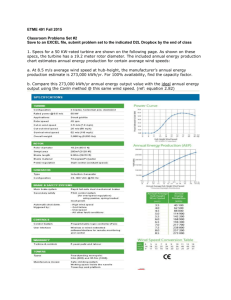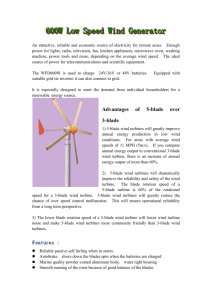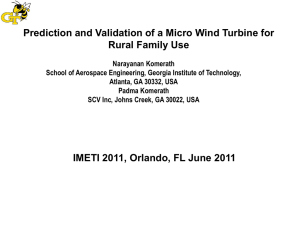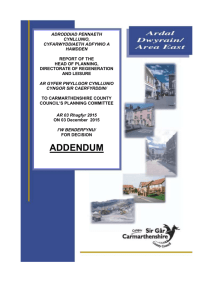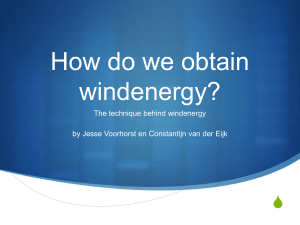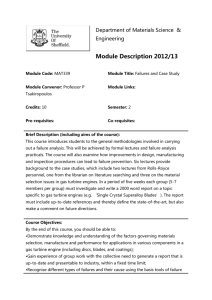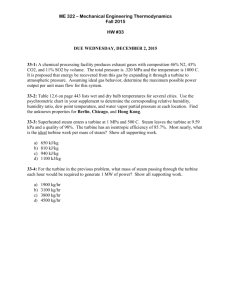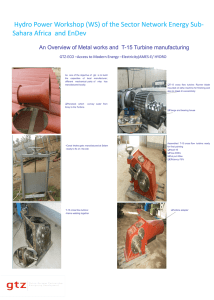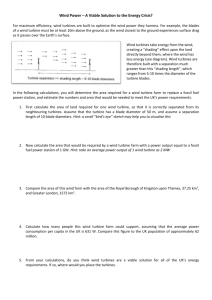ijetmr investigate the effect of different design parameter on
advertisement
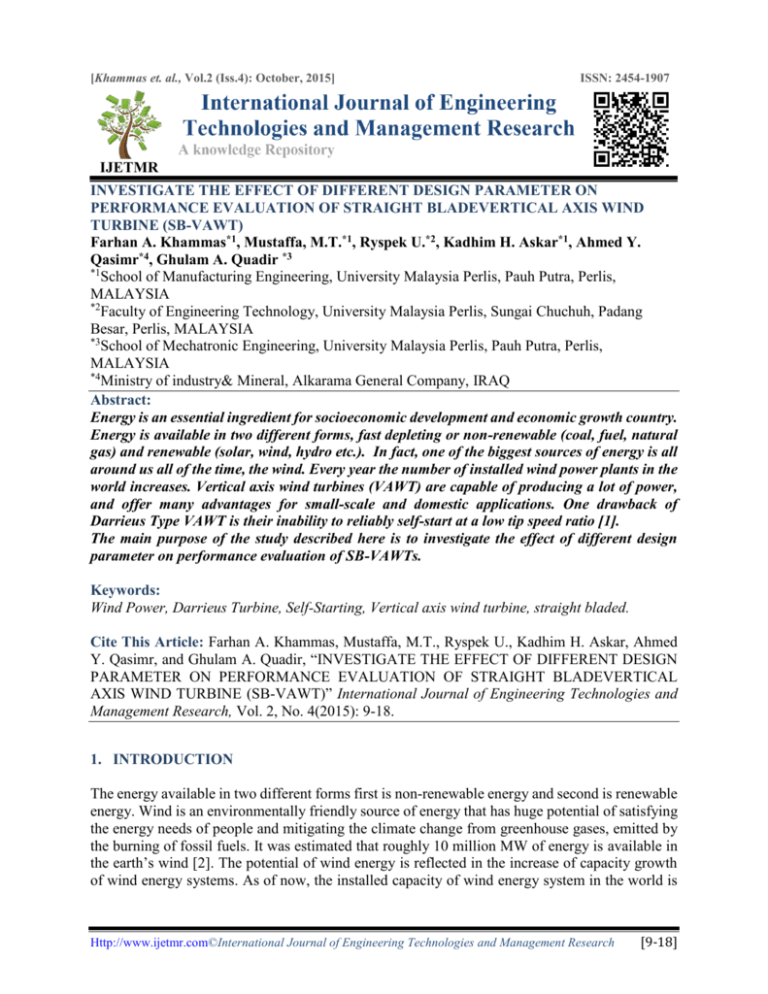
[Khammas et. al., Vol.2 (Iss.4): October, 2015] ISSN: 2454-1907 IJETMR INVESTIGATE THE EFFECT OF DIFFERENT DESIGN PARAMETER ON PERFORMANCE EVALUATION OF STRAIGHT BLADEVERTICAL AXIS WIND TURBINE (SB-VAWT) Farhan A. Khammas*1, Mustaffa, M.T.*1, Ryspek U.*2, Kadhim H. Askar*1, Ahmed Y. Qasimr*4, Ghulam A. Quadir *3 *1 School of Manufacturing Engineering, University Malaysia Perlis, Pauh Putra, Perlis, MALAYSIA *2 Faculty of Engineering Technology, University Malaysia Perlis, Sungai Chuchuh, Padang Besar, Perlis, MALAYSIA *3 School of Mechatronic Engineering, University Malaysia Perlis, Pauh Putra, Perlis, MALAYSIA *4 Ministry of industry& Mineral, Alkarama General Company, IRAQ Abstract: Energy is an essential ingredient for socioeconomic development and economic growth country. Energy is available in two different forms, fast depleting or non-renewable (coal, fuel, natural gas) and renewable (solar, wind, hydro etc.). In fact, one of the biggest sources of energy is all around us all of the time, the wind. Every year the number of installed wind power plants in the world increases. Vertical axis wind turbines (VAWT) are capable of producing a lot of power, and offer many advantages for small-scale and domestic applications. One drawback of Darrieus Type VAWT is their inability to reliably self-start at a low tip speed ratio [1]. The main purpose of the study described here is to investigate the effect of different design parameter on performance evaluation of SB-VAWTs. Keywords: Wind Power, Darrieus Turbine, Self-Starting, Vertical axis wind turbine, straight bladed. Cite This Article: Farhan A. Khammas, Mustaffa, M.T., Ryspek U., Kadhim H. Askar, Ahmed Y. Qasimr, and Ghulam A. Quadir, “INVESTIGATE THE EFFECT OF DIFFERENT DESIGN PARAMETER ON PERFORMANCE EVALUATION OF STRAIGHT BLADEVERTICAL AXIS WIND TURBINE (SB-VAWT)” International Journal of Engineering Technologies and Management Research, Vol. 2, No. 4(2015): 9-18. 1. INTRODUCTION The energy available in two different forms first is non-renewable energy and second is renewable energy. Wind is an environmentally friendly source of energy that has huge potential of satisfying the energy needs of people and mitigating the climate change from greenhouse gases, emitted by the burning of fossil fuels. It was estimated that roughly 10 million MW of energy is available in the earth’s wind [2]. The potential of wind energy is reflected in the increase of capacity growth of wind energy systems. As of now, the installed capacity of wind energy system in the world is Http://www.ijetmr.com©International Journal of Engineering Technologies and Management Research [9-18] [Khammas et. al., Vol.2 (Iss.4): October, 2015] ISSN: 2454-1907 194,390 MW [3]. Wind power is a major source of sustainable energy and can be harvested using both horizontal axis wind turbine and vertical axis wind turbine. In current scenario, the horizontal axis wind turbine is the recent trend for wind energy utilization for power generation. However, HAWTs suitable for higher wind velocity and subjected to higher cost and complex system; which puts a limitation in their applications for domestic applications. To overcome these problems and to utilize the wind energy even at low wind velocity and at low cost, vertical axis wind turbine is one of the attracting alternatives. After reviewing the various literature of the vertical axis wind turbine a symmetrical airfoil gives good performance [4]. During the 1970s and 1980s vertical axis, machines came back into focus when both Canada and the United States built several prototypes of Darrieus turbines. The prototypes proved to be quite efficient and reliable [5]. Straight-bladed VAWT was also an invention included in the Darrieus patent [9]. This turbine is usually referred to as the straight-bladed Darrieus turbine or the H-rotor, but has also been called giromill or Cyclo-turbine (different concepts of the same invention) as shown in Figure 1 [6]. Figure 1. (A) Savonius rotor, (B) Darrieus turbine (C) H-rotor. Merits of vertical axis wind turbines over horizontal axis wind turbines are shown in Table 1. Table 1: Merits of (VAWTs) over (HAWTs) [7] Http://www.ijetmr.com©International Journal of Engineering Technologies and Management Research [9-18] [Khammas et. al., Vol.2 (Iss.4): October, 2015] ISSN: 2454-1907 There are many different types of wind turbines and they can be divided into two groups of turbines, depending on the orientation of their axis of rotation, namely horizontal axis wind turbines (HAWTs) and vertical axis wind turbines (VAWTs) as shown in Figure 2. Figure 2: Wind turbine types There are two principle designs of VAWTs, the Darrieus wind turbine used to generate electricity from the energy carried in the wind and the Savonius wind turbines, which are drag based VAWTs that operate on the theory and principle of a paddle propelling a boat through water. There are several configurations of the Darrieus type. Some of these Darrieus configurations are the focus of current research. Straight Blade Darrieus, type VAWT, also called giromill and Cycloturbine, have been manufactured in recent years with different specifications. Some parameters affect the performance of these turbines. Some of the most significant variables are Turbine solidity, Number of blades, Airfoil selection, Blade pitch angle and Turbine aspect ratio (H/D) [1]. 2. STRAIGHT BLADE DARRIEUS TYPE VERTICAL AXIS WIND TURBINE CONCEPT A. Working Principal Darrieus, or H-Darrieus, VAWT works on the principle of lift to generate torque, the flow velocities of Darrieus wind turbine can be seen in Figure 3. Http://www.ijetmr.com©International Journal of Engineering Technologies and Management Research [9-18] [Khammas et. al., Vol.2 (Iss.4): October, 2015] ISSN: 2454-1907 Figure 3: Flow velocities of Darrieus wind turbine Tangential velocity Vt and Normal velocity Vn of the blade which is given by [8], 𝑉t= 𝑅𝜔 + 𝑉𝑎 cos 𝜃 (1) 𝑉𝑛 = 𝑉𝑎 sin 𝜃 (2) The relative flow velocity (W) can be obtained as 𝑊 = √𝑉𝑡 2 − 𝑉𝑛2 (3) From Figure 3, the normal and tangential coefficient can be obtained as: 𝐶𝑡 = 𝐶𝑙 𝑠𝑖𝑛𝛼 − 𝐶𝑑 cos 𝛼 (4) 𝐶𝑛 = 𝐶𝑙 𝑐𝑜𝑠𝛼 + 𝐶𝑑 𝑠𝑖𝑛 𝛼 (5) Figure 4: Normal and Tangential force coefficients on blade Http://www.ijetmr.com©International Journal of Engineering Technologies and Management Research [9-18] [Khammas et. al., Vol.2 (Iss.4): October, 2015] ISSN: 2454-1907 The normal and the tangential force coefficients on the blade are shown in Figure 4, and the net tangential and normal forces defined as: 𝐹𝑡 = 𝐶𝑡 1 𝐹𝑛 = 𝐶𝑛 1 2 𝜌𝐶𝐻𝑊 2 2 (6) 𝜌𝐶𝐻𝑊 2 (7) Where, Fn normal force, Ft tangential force, C blade chord, H height of turbine blade and W the relative flow velocity. B. Performance Evaluation Wind turbine performance is commonly characterized by the relationship of the coefficient of performance (Cp) to the turbine tip speed ratio as shown in Figure 5 [1]. Figure 5: Performance characteristics of Cp Vs TSR graph The turbine Cp is defined as: 𝐶𝑝 = 𝑃𝑜𝑢𝑡 (8) 0.5𝜌𝑈 2 ∞ 𝑆 Where U∞ is the nominal wind speed, ρ is the air density, and S is the swept area of the turbine (for an H-Darrieus, S = L × D, where L is the blade length, and D is the turbine diameter). The tip speed ratio (abbreviated here as TSR) is the ratio of the turbine blade speed to the nominal wind velocity, and is given by [1]: 𝑇𝑆𝑅 = ωR 𝑈∞ (9) Where ω is the angular velocity of the turbine, and R is the equatorial radius. Http://www.ijetmr.com©International Journal of Engineering Technologies and Management Research [9-18] [Khammas et. al., Vol.2 (Iss.4): October, 2015] ISSN: 2454-1907 In Figure 6, a plot is generated to observe the variation of rotor TSR with increase of H/D. From this plot it is observed that TSR of the rotor increases with the increase of H/D up to a certain limit, but then decreases with further increase of the latter for any wind speed conditions. For any H/D, TSR increases with increase of wind speed, meaning blade rotates at a rate greater than that of wind speed [9]. Figure6: Variation of tip speed ratio with aspect ratio. Other parameters which are used to distinguish between various turbine configurations include the chord, radius ratio, c/r, and the turbine solidity which is the ratio of turbine blade area to turbine swept area, and is expressed as: 𝜎= 𝑁𝐶 𝑅 (10) Where N is the number of blades and C is chord of wind blade. The rotor solidity can be measured using eq. 1 in which rotor diameter (D) can be calculated from the considered aspect ratios (H/D) of the rotor, namely 0.8, 0.9, 1.0 & 1.1 & 1.2. The rotor height (H) of each design is kept constant at 30 cm. Again, for the present rotor with a number of blades (N) as 3 and blade chord (C) as 10 cm, the solidity values are exactly same as the rotor aspect ratios. The usual practice in the literature is to increase or decrease the number of blades to alter solidity, but in the present approach, the rotor diameter was varied to alter the same. For the dynamic performance of the rotor, the variations of the power coefficient (Cp) with respect to solidity (H/D), wind speed and tip speed ratio (TSR) are analyzed. But before that power loss due to struts' parasitic drag and that due to bearing friction have been evaluated as shown in Figure 7 (a). Parasitic power of struts is more than that of bearing frictional power within the operating range of the turbine, but both are much less than 0.1 W. Figure 7 (b) shows the variety of coping with wind speed for the selected values of H/D from 0.8 to 1.2. The figure clearly shows that Cp increases with the increase of wind speed up to the maximum and then decreases with further increase of the latter beyond 5.7 m/s. Moreover, H/D ¼ 1.0 is the optimum condition of rotor solidity for any wind speed conditions in terms of higher power coefficient values than any other solidity conditions. The highest Cp of (0.32) is obtained at a wind speed of (5.7) m/s for the optimum rotor solidity 1.0 [9]. Http://www.ijetmr.com©International Journal of Engineering Technologies and Management Research [9-18] [Khammas et. al., Vol.2 (Iss.4): October, 2015] ISSN: 2454-1907 Figure 7: (a): Struts parasitic power loss and bearing friction power loss. (b): Variation of Cp with respect to wind velocity at different solidities In order to determine the self-starting ability of the present rotor, an experimental investigation was conducted to evaluate the static torque coefficients at different rotor azimuthal angles over a Complete cycle of rotation for different rotor solidities or rotor aspect ratios (H/D), namely 0.8, 0.9, 1.0, 1.1 & 1.2. It has been found that the rotor self-starts irrespective of rotor position for all the solidities considered as the static torque coefficients are positive for all azimuthal positions Figure 8. It can also be seen from Figure 8 that the starting torque increases as the solidity increases, meaning the better self-starting ability of the rotor during start-up with increased solidity [9]. Figure 8: Variation of static torque coefficient with rotor azimuthal positions for different (H/D). Http://www.ijetmr.com©International Journal of Engineering Technologies and Management Research [9-18] [Khammas et. al., Vol.2 (Iss.4): October, 2015] ISSN: 2454-1907 Li, S., and Li Y. [10] made a series of numerical analysis about the effect of solidity on a straightbladed VAWT. In their work, they do two-dimensional CFD simulations of the flow field around a three-bladed, four-bladed and five-bladed Darrieus rotor are performed, with the aim of determining the influence of blade number on the performance of the vertical axis wind turbine. The solutions are obtained using unstructured moving grids rotating with the turbine blades. For each configuration, the flow field characteristics are investigated at several value of the tip speed ratio, in order to analyze the changes in the behavior of the turbine, due to the variation of blade number. The peak power coefficients for the three analyzed rotor configurations are presented in Table 3. Using the power coefficient of the three-bladed turbine as a reference, a 5% performance decrease is registered for the four-bladed configuration, while the five-bladed architecture exhibits a 15% lowering in the performance. The value of the tip speed ratio to obtain the peak power is lowered by 9% for the four-bladed configuration and of 21% for the five-bladed architecture [11]. Table 2: Values of peak power and corresponding tip speed ratios Figure 9 shows the torque coefficient, defined as: 1 𝐶𝑡 = 𝑇( 𝜌𝐴𝑅𝑟𝑜𝑡𝑜𝑟 𝑉∞2 ) 2 (11) As a function of the angular position of blade No. 1 (only a single period of revolution is represented for each rotor configuration). Figure 9: Torque coefficient as a function of the angular position of blade No. 1 (single period plotted), optimal tip speed ratio (TSR =2. 58 for N=3, TSR =2. 33 for N=4, TSR=2. 04 for N=5) Http://www.ijetmr.com©International Journal of Engineering Technologies and Management Research [9-18] [Khammas et. al., Vol.2 (Iss.4): October, 2015] ISSN: 2454-1907 As can be seen, with the increase of blade number the torque coefficient peak becomes lower and the frequency of the oscillations in the torque is increased. This happened because in a completely 360° rotation of the rotor, the number of periods becomes higher. The average, maximum and minimum value of CT for the three analyzed rotors is represented in Table 3, for the tip speed ratio of the maximum power coefficient. It can be seen that if the blade number is increased, the oscillations of Ct are reduced, while its average value remain almost constant. Table 3: The values of the torque coefficient for the three analyzed rotor Configurations 3. CONCLUSIONS VAWT having good capability of extracting more power from low wind than HAWT. It has poor self-starting capability at low wind speed. This problem must solve for effective use of VAWT for domestic purpose. SB-VAWT having the effect of parameters like Blade aerodynamics, Solidity, Pitch angle, Number of blades and TSR on performance. It is proved that 3 blades VAWT more efficient than 2 or 4 blade. Solidity of 0.2- 0.4 are more efficient. Using the power coefficient of the three-bladed turbine as a reference, a 5% performance decrease registered for the four-bladed configuration, while the five-bladed architecture exhibits a 15% lowering in the performance as in Table 2. The value of the tip speed ratio to obtain the peak power lowered by 9% for the four-bladed configuration and of 21% for the five-bladed architecture as in Table 2. The numerically predicted peak of power coefficient lowered with the increase of rotor solidity, while it moved to lower tip speed ratio. Numerical analysis performed in order to understand the effect of blade number on the behavior of a straight-bladed vertical-axis wind turbine. In fact, a larger number of blades allowed to reach the maximum power coefficient form lower angular velocities, however, efficiency is more concerned. With the increase of blade number the torque coefficient peak becomes lower and the frequency of the oscillations in the torque is increased. For the tip speed ratio of maximum power coefficient, it can be seen that if the blade number is increased, the oscillations of Ct are reduced, while its average value remains almost constant as in Table 3. Http://www.ijetmr.com©International Journal of Engineering Technologies and Management Research [9-18] [Khammas et. al., Vol.2 (Iss.4): October, 2015] 4. [1] [2] [3] [4] [5] [6] [7] [8] [9] [10] [11] ISSN: 2454-1907 REFERENCES Chirag Soni1 Smit Thakkar, Review on Aerodynamic Performance Evaluation of Straight Blade Vertical Axis Wind Turbine, IJSRD - International Journal for Scientific Research & Development| Vol. 2, Issue 08, 2014 | ISSN (online): 2321-0613 Global wind energy market as of 2006. Press release of Global Wind Energy Council (GWEC), www.gwec.net/publications/global-wind-report-2 (2010 accessed 9 July 2006). Global wind energy market as of 2010. Press release of Global Wind Energy Council ([2] Tapan H. Barot1, Hitesh Jariwala2, MayurKevadiy A Review on Straight Bladed Vertical Axis H-Type Darrieus Wind Turbine, International Journal of Innovative Research in Science, Engineering and Technology, Vol. 4, Special Issue 6, May 2015 Peace, S. Another approach to wind (cover story). Matchen 2004;126 (6): 28GWEC), Diaries GJM. Turbine having its rotating shaft transverse to the flow of the current. US Patent no 1.835.018, 1931. Muhammad Mahmood Aslam Bhutta, Nasir Hayat, Ahmed Uzair Farooq, Zain Ali, ShRehan Jamil and Zahid Hussain, “Vertical axis wind turbine – A review of various configurations and design techniques” in Renewable and Sustainable Energy Reviews, vol. 16, 2012, pp 1926– 1939. Mazharul Islam_, David S.-K. Ting, Amir Fartaj, Aerodynamic models for Darrieus-type straight-bladed vertical axis wind turbines, Renewable and Sustainable Energy Reviews 12 (2008) 1087–1109 Singh, M.A., Biswas A., Misra R.D., Investigation of self-starting and high rotor solidity on the performance of a three S1210 blade H-type Darrieus rotor a Deptt. Of Mechanical Engg, NIT Silchar, Silchar, Assam 788 010, India Renewable Energy 76 (2015) 381e387 Li, S., Li Y., Numerical study on the performance effects of solidity on the straight-bladed vertical axes wind turbine, Power and energy Engineering Conference, 2010 Marco RacitiCastelli, Stefano De Betta and Ernesto Benini, Effect of Blade Number on a Straight-Bladed Vertical-Axis Darreius Wind Turbine, International Journal of Mechanical and Aerospace Engineering 6 2012 Http://www.ijetmr.com©International Journal of Engineering Technologies and Management Research [9-18]
